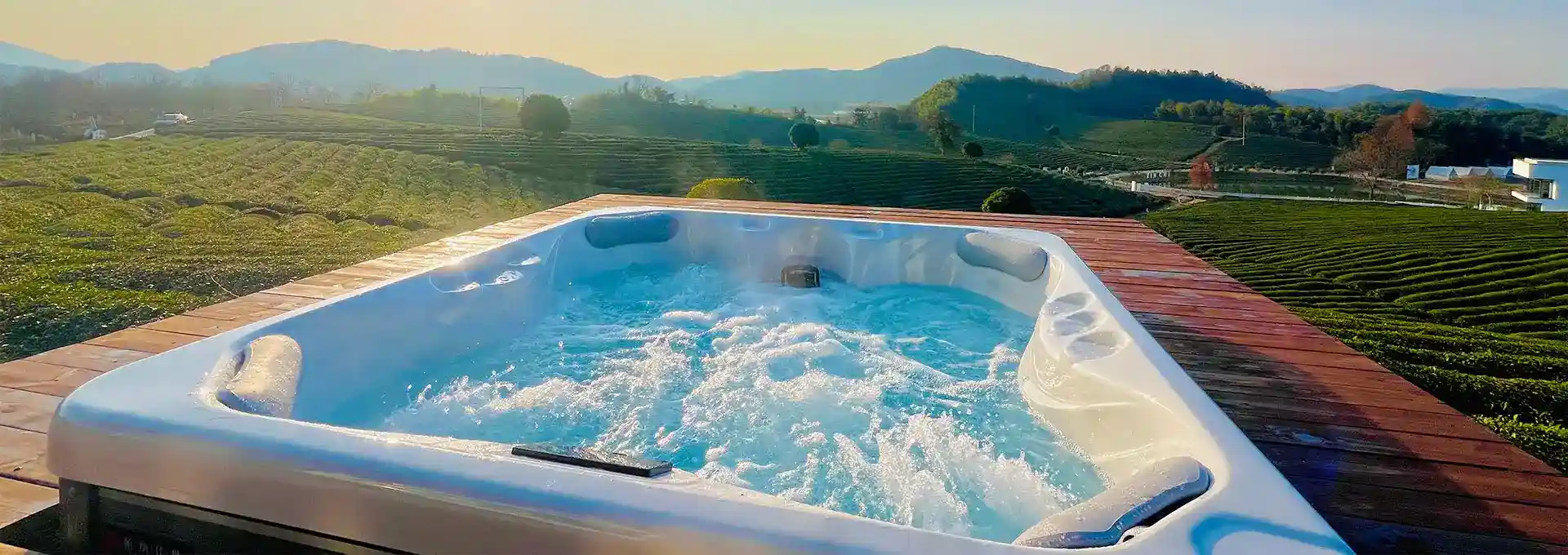What Causes Low pH in Hot Tubs?
2024-09-25 09:25:04
Low pH in hot tubs is a common issue that can affect water quality and user comfort. pH is a measure of how acidic or basic the water is, with a scale ranging from 0 to 14. For hot tubs, the ideal pH range is typically between 7.2 and 7.8. When the pH drops below this range, it's considered low or acidic. Several factors can contribute to low pH in hot tubs, including heavy bather load, improper chemical balance, and environmental influences. Understanding these causes is crucial for maintaining a safe and enjoyable hot tub experience, especially for outdoor luxury hot tubs where water chemistry can be more challenging to manage due to exposure to the elements.
How Often Should You Change the Water in an Outdoor Hot Tub?
Maintaining proper water quality in an outdoor luxury hot tub is essential for both the longevity of the tub and the health of its users. One crucial aspect of this maintenance is knowing when to change the water. The frequency of water changes depends on various factors, including usage, water chemistry, and environmental conditions.
Generally, it's recommended to change the water in an outdoor hot tub every 3 to 4 months. However, this timeline can vary based on how often you use the tub and how well you maintain it. For heavily used hot tubs or those in areas with high levels of airborne contaminants, more frequent water changes may be necessary.
Several signs indicate it's time to change your hot tub water:
1. Cloudy or foamy water that doesn't clear up with proper chemical treatment
2. Difficulty maintaining proper pH and sanitizer levels
3. Unusual odors coming from the water
4. A noticeable change in water color
5. The accumulation of total dissolved solids (TDS) exceeding 1,500 parts per million
To extend the time between water changes and maintain optimal water quality, consider the following practices:
- Regular testing and balancing of water chemistry
- Cleaning or replacing filters as recommended by the manufacturer
- Showering before entering the hot tub to reduce the introduction of contaminants
- Using a hot tub cover when the tub is not in use to prevent debris from entering
- Implementing a routine shock treatment to oxidize organic contaminants
By following these practices, you can ensure that your outdoor luxury hot tub remains a clean and inviting oasis for relaxation and enjoyment. Remember that proper water maintenance not only enhances your hot tub experience but also protects your investment by preventing damage to the tub's components and surfaces.
What Are the Benefits of Using an Outdoor Hot Tub in Winter?
While many associate hot tub use with warm weather, using an outdoor luxury hot tub during winter can offer a unique and rewarding experience. The contrast between the cold air and the warm water creates a sensory delight that can be both invigorating and relaxing. Here are some of the key benefits of using an outdoor hot tub in winter:
1. Improved Circulation: The warm water of a hot tub can help improve blood circulation, which is particularly beneficial in cold weather when our bodies tend to constrict blood vessels to conserve heat.
2. Stress Relief: The combination of warm water, massage jets, and the serene winter landscape can create a perfect environment for stress relief and relaxation.
3. Pain Relief: For those suffering from joint pain or muscle aches, the buoyancy and warmth of the water can provide significant relief, which can be especially welcome during colder months when these conditions often worsen.
4. Enhanced Sleep Quality: A soak in a hot tub before bedtime can help raise your body temperature, which, when followed by the natural cooling process, can signal your body that it's time to sleep, potentially improving your sleep quality.
5. Respiratory Benefits: The steam from the hot water can help clear nasal passages and provide relief from cold and flu symptoms, which are more common during winter months.
6. Skin Health: The increased circulation from hot tub use can promote healthier skin, helping to combat the dryness often associated with winter weather.
7. Social Benefits: An outdoor hot tub can serve as a unique gathering spot for friends and family during winter, encouraging social interaction and creating memorable experiences.
8. Connection with Nature: Using an outdoor hot tub in winter allows you to enjoy the beauty of the season - snow-covered landscapes, starry nights, and crisp air - while remaining comfortably warm.
9. Increased Home Value: A well-maintained outdoor luxury hot tub can be a valuable addition to your property, potentially increasing its market value and appeal.
10. Year-Round Use: By using your hot tub in winter, you maximize your investment by enjoying it all year round rather than limiting its use to warmer months.
To fully enjoy these benefits, it's important to take some precautions when using an outdoor hot tub in winter:
- Ensure the area around the hot tub is clear of ice and snow to prevent slips and falls.
- Keep a robe or towel close by for when you exit the tub.
- Limit your soaking time to avoid overheating or dehydration.
- Stay hydrated by drinking water before, during, and after your hot tub session.
- Maintain proper water chemistry to ensure a safe and comfortable soaking environment.
By embracing the unique pleasures of winter hot tub use, you can transform the coldest months of the year into a time of warmth, relaxation, and rejuvenation.
How Do You Maintain Water Quality in an Outdoor Luxury Hot Tub?
Maintaining water quality in an outdoor luxury hot tub is crucial for ensuring a safe, comfortable, and enjoyable experience. Proper maintenance not only protects the health of users but also extends the life of your hot tub and its components. Here are key strategies for maintaining optimal water quality in your outdoor luxury hot tub:
1. Regular Testing: Test your hot tub water at least 2-3 times a week using test strips or a liquid test kit. Check for pH, alkalinity, sanitizer levels (chlorine or bromine), and calcium hardness. Adjust chemicals as needed based on the test results.
2. Balancing pH: Keep the pH level between 7.2 and 7.8. Low pH can cause equipment corrosion and skin irritation, while high pH can lead to scaling and reduced sanitizer effectiveness. Use pH increasers or decreasers as needed to maintain the proper range.
3. Sanitizer Maintenance: Use either chlorine or bromine as your primary sanitizer. Maintain chlorine levels between 1-3 ppm (parts per million) or bromine levels between 3-5 ppm. Shock the water weekly or after heavy use to eliminate contaminants and restore sanitizer effectiveness.
4. Alkalinity Control: Total alkalinity should be maintained between 80-120 ppm. Proper alkalinity helps stabilize pH levels and prevents rapid fluctuations.
5. Calcium Hardness Management: Keep calcium hardness levels between 150-250 ppm to prevent scaling or corrosion. In areas with hard water, use a sequestering agent to prevent calcium buildup.
6. Filtration System Care: Clean or rinse your filters every 2-4 weeks, depending on usage. Deep clean them every 3-4 months and replace them annually or as recommended by the manufacturer.
7. Water Circulation: Run your hot tub's circulation system for at least 4-6 hours daily to ensure proper filtration and chemical distribution.
8. Regular Cleaning: Wipe down the waterline and jets regularly to prevent biofilm buildup. Use a hot tub-specific cleaner to avoid introducing contaminants.
9. Cover Maintenance: Keep your hot tub covered when not in use to prevent debris from entering and to maintain water temperature. Clean the cover regularly and treat it with a protectant to extend its life.
10. Water Changes: Drain and refill your hot tub every 3-4 months, or more frequently with heavy use. This helps prevent the buildup of total dissolved solids (TDS) that can affect water quality and equipment efficiency.
11. Shower Before Use: Encourage all users to shower before entering the hot tub to reduce the introduction of contaminants like oils, lotions, and bacteria.
12. Proper Chemical Storage: Store hot tub chemicals in a cool, dry place away from direct sunlight and out of reach of children and pets. Always follow manufacturer instructions for handling and use.
13. Professional Maintenance: Consider having a professional service your hot tub periodically to ensure all systems are functioning correctly and to address any potential issues early.
14. Educate Users: Inform all hot tub users about proper hygiene practices and usage guidelines to help maintain water quality.
15. Monitor Water Clarity: If the water becomes cloudy or develops an unusual odor, address the issue immediately by testing and adjusting water chemistry.
By following these maintenance practices, you can ensure that your outdoor luxury hot tub remains a clean, safe, and inviting retreat. Remember that consistency is key in hot tub maintenance. Regular care not only prevents problems but also makes the maintenance process easier and more cost-effective in the long run.
Proper water quality management also contributes to the overall longevity of your hot tub, protecting your investment and ensuring that you can enjoy your outdoor oasis for years to come. With a well-maintained hot tub, you can relax and unwind, confident in the knowledge that you're soaking in clean, balanced, and safe water.
For more information on hot tub installations and to find out more about our products, please feel free to contact us at info@iparnassus.com.
References:
1. Lowry, S. (2021). The Complete Guide to Hot Tub Water Chemistry. Swim University.
2. Pool and Hot Tub Alliance. (2022). Water Quality in Spas and Hot Tubs.
3. Aqua Magazine. (2023). Best Practices for Hot Tub Water Maintenance.
4. Leslie's Pool Supplies. (2022). How to Balance Hot Tub Water.
5. Hot Spring Spas. (2023). Hot Tub Maintenance Guide.
6. Bullfrog Spas. (2022). Winter Hot Tub Benefits and Maintenance Tips.
7. Caldera Spas. (2023). Year-Round Hot Tub Use: Seasonal Benefits and Care.
8. Master Spas. (2022). Hot Tub Water Change Frequency and Best Practices.
9. Jacuzzi. (2023). Outdoor Hot Tub Maintenance: A Comprehensive Guide.
10. Spa Depot. (2022). Understanding and Managing Hot Tub pH Levels.



